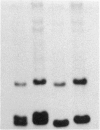Abstract
We have analyzed the segregation of five loci in the region Xq27/28 in a large family affected by the fragile X syndrome. The marker DXS115 (767) is shown to be polymorphic with the enzyme PstI, as well as with BstXI. This marker will be useful in the analysis of both fragile X and haemophilia A families. The data presented here are consistent with the following order of loci: Xcen-F9-DXS105(cX55.7,55E)-DXS98(4D-8)- FRAXA-DXS52(St14)-DXS115(767)-qter.
Full text
PDF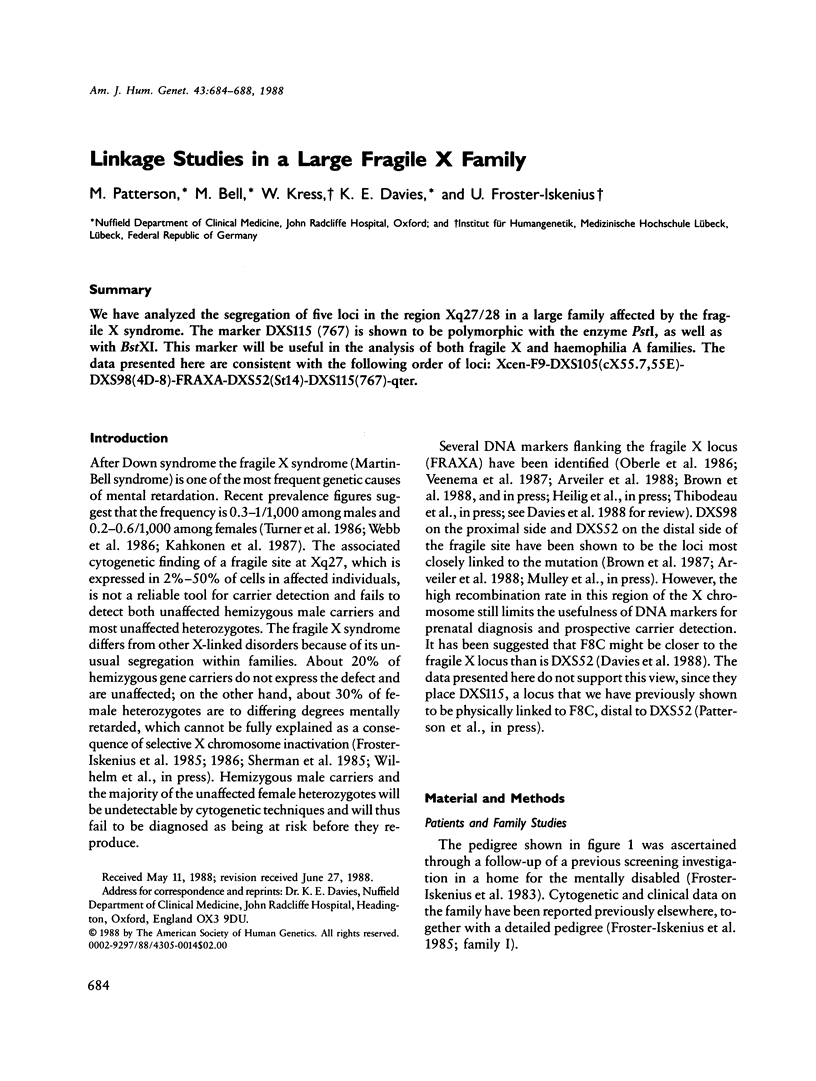
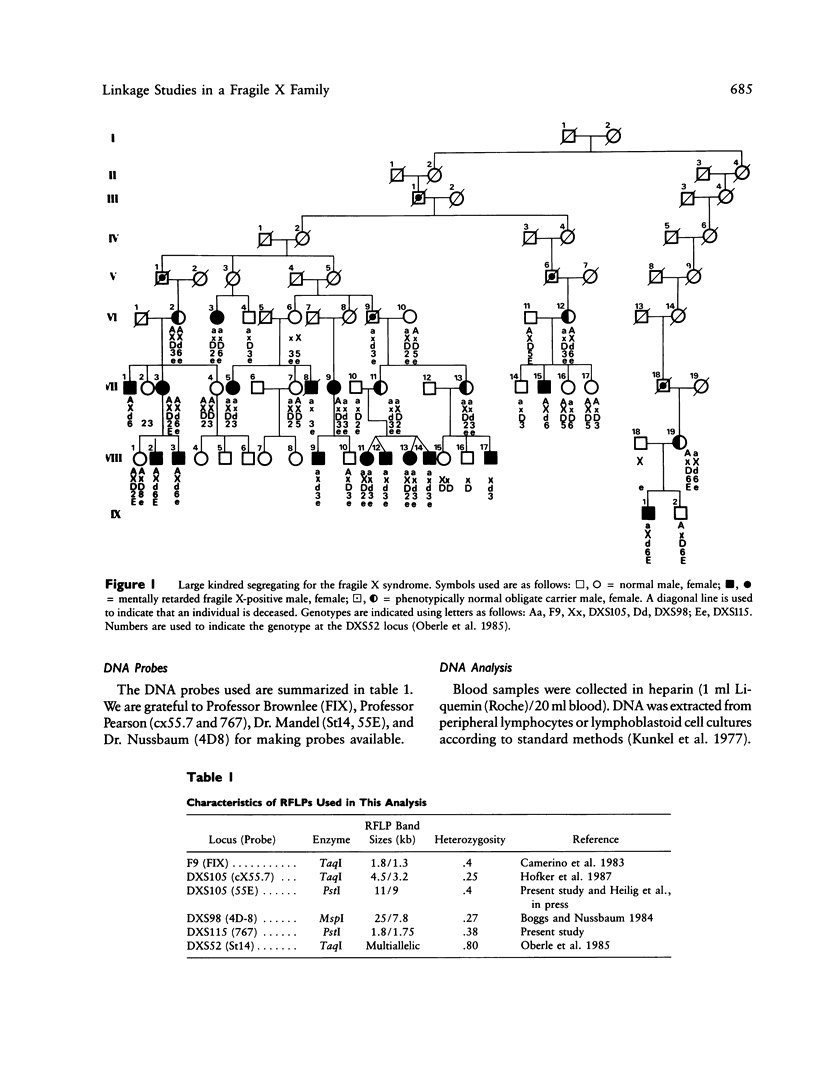
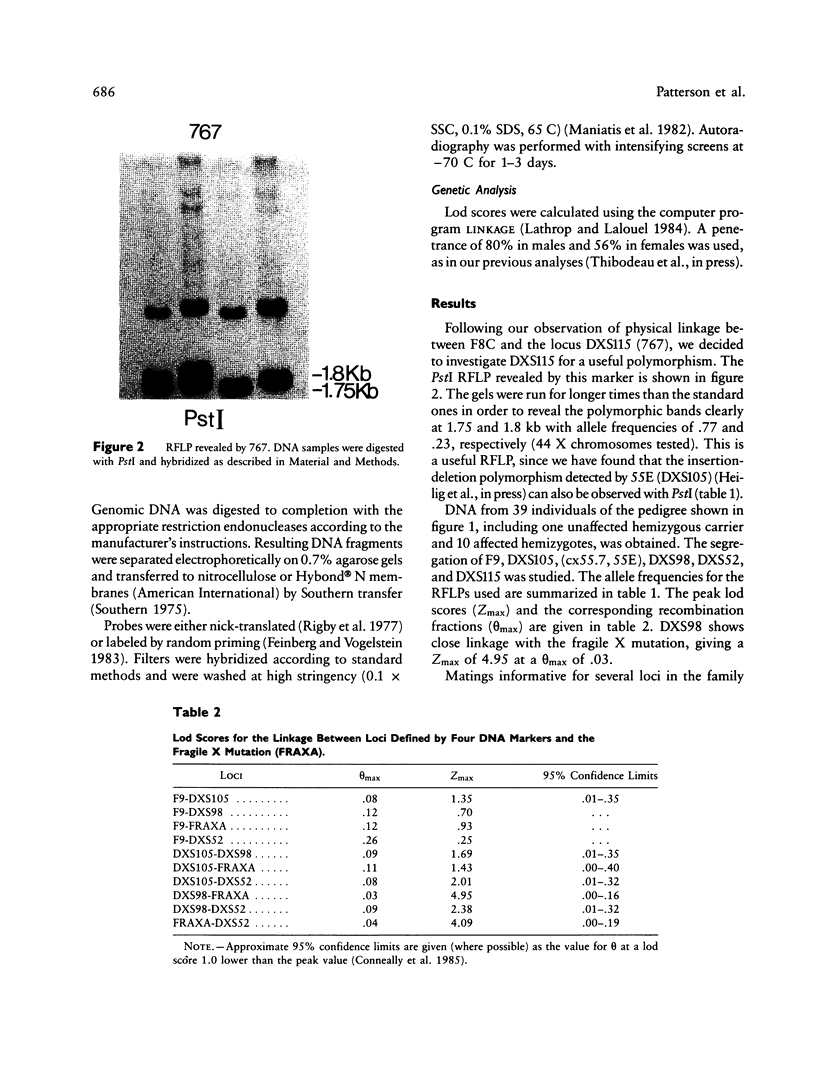
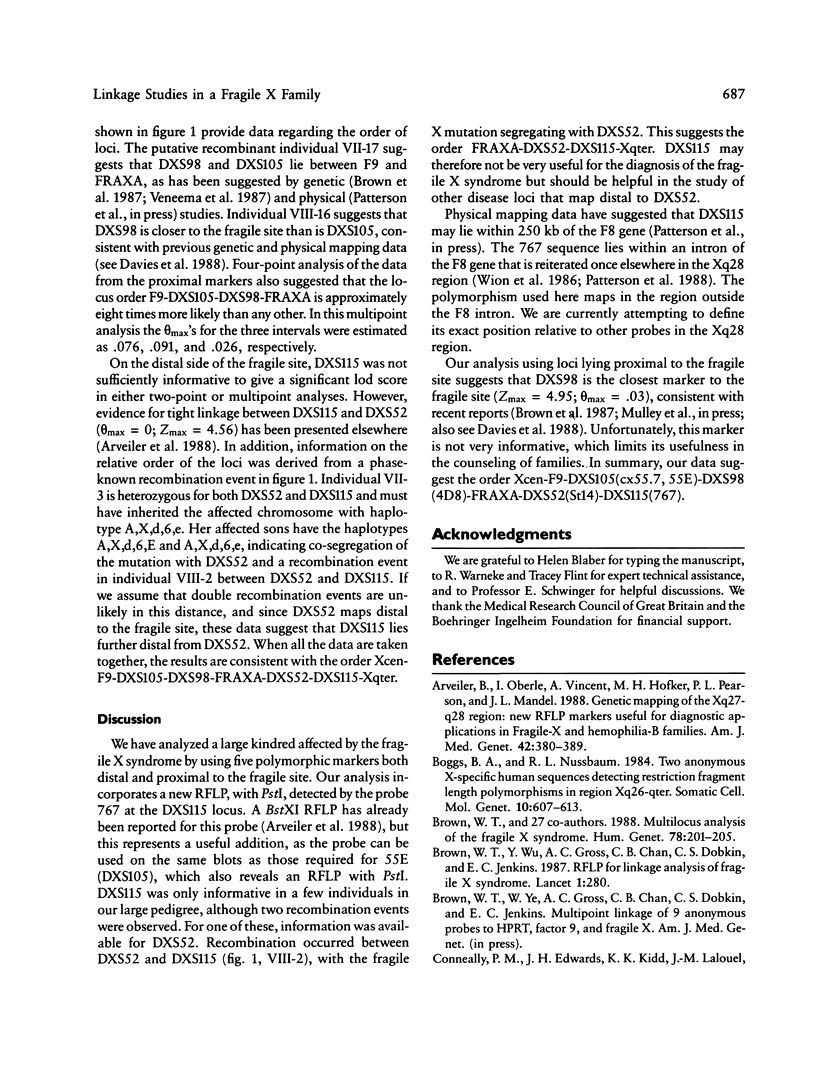

Images in this article
Selected References
These references are in PubMed. This may not be the complete list of references from this article.
- Arveiler B., Oberlé I., Vincent A., Hofker M. H., Pearson P. L., Mandel J. L. Genetic mapping of the Xq27-q28 region: new RFLP markers useful for diagnostic applications in fragile-X and hemophilia-B families. Am J Hum Genet. 1988 Feb;42(2):380–389. [PMC free article] [PubMed] [Google Scholar]
- Boggs B. A., Nussbaum R. L. Two anonymous X-specific human sequences detecting restriction fragment length polymorphisms in region Xq26----qter. Somat Cell Mol Genet. 1984 Nov;10(6):607–613. doi: 10.1007/BF01535226. [DOI] [PubMed] [Google Scholar]
- Brown W. T., Gross A., Chan C., Jenkins E. C., Mandel J. L., Oberlé I., Arveiler B., Novelli G., Thibodeau S., Hagerman R. Multilocus analysis of the fragile X syndrome. Hum Genet. 1988 Mar;78(3):201–205. doi: 10.1007/BF00291662. [DOI] [PubMed] [Google Scholar]
- Brown W. T., Wu Y., Gross A. C., Chan C. B., Dobkin C. S., Jenkins E. C. RFLP for linkage analysis of fragile X syndrome. Lancet. 1987 Jan 31;1(8527):280–280. doi: 10.1016/s0140-6736(87)90103-6. [DOI] [PubMed] [Google Scholar]
- Conneally P. M., Edwards J. H., Kidd K. K., Lalouel J. M., Morton N. E., Ott J., White R. Report of the Committee on Methods of Linkage Analysis and Reporting. Cytogenet Cell Genet. 1985;40(1-4):356–359. doi: 10.1159/000132186. [DOI] [PubMed] [Google Scholar]
- Davies K. E., Mandel J. L., Weissenbach J., Fellous M. Report of the committee on the genetic constitution of the X and Y chromosomes. Cytogenet Cell Genet. 1987;46(1-4):277–315. doi: 10.1159/000132481. [DOI] [PubMed] [Google Scholar]
- Feinberg A. P., Vogelstein B. A technique for radiolabeling DNA restriction endonuclease fragments to high specific activity. Anal Biochem. 1983 Jul 1;132(1):6–13. doi: 10.1016/0003-2697(83)90418-9. [DOI] [PubMed] [Google Scholar]
- Froster-Iskenius U., Felsch G., Schirren C., Schwinger E. Screening for fra(X)(q) in a population of mentally retarded males. Hum Genet. 1983;63(2):153–157. doi: 10.1007/BF00291535. [DOI] [PubMed] [Google Scholar]
- Froster-Iskenius U., McGillivray B. C., Dill F. J., Hall J. G., Herbst D. S. Normal male carriers in the fra(X) form of X-linked mental retardation (Martin-Bell syndrome). Am J Med Genet. 1986 Jan-Feb;23(1-2):619–631. doi: 10.1002/ajmg.1320230156. [DOI] [PubMed] [Google Scholar]
- Froster-Iskenius U., Schulze A., Schwinger E. Transmission of the marker X syndrome trait by unaffected males: conclusions from studies of large families. Hum Genet. 1984;67(4):419–427. doi: 10.1007/BF00291403. [DOI] [PubMed] [Google Scholar]
- Hofker M. H., Bergen A. A., Skraastad M. I., Carpenter N. J., Veenema H., Connor J. M., Bakker E., van Ommen G. J., Pearson P. L. Efficient isolation of X chromosome-specific single-copy probes from a cosmid library of a human X/hamster hybrid-cell line: mapping of new probes close to the locus for X-linked mental retardation. Am J Hum Genet. 1987 Apr;40(4):312–328. [PMC free article] [PubMed] [Google Scholar]
- Kunkel L. M., Smith K. D., Boyer S. H., Borgaonkar D. S., Wachtel S. S., Miller O. J., Breg W. R., Jones H. W., Jr, Rary J. M. Analysis of human Y-chromosome-specific reiterated DNA in chromosome variants. Proc Natl Acad Sci U S A. 1977 Mar;74(3):1245–1249. doi: 10.1073/pnas.74.3.1245. [DOI] [PMC free article] [PubMed] [Google Scholar]
- Kähkönen M., Alitalo T., Airaksinen E., Matilainen R., Launiala K., Autio S., Leisti J. Prevalence of the fragile X syndrome in four birth cohorts of children of school age. Hum Genet. 1987 Sep;77(1):85–87. doi: 10.1007/BF00284720. [DOI] [PubMed] [Google Scholar]
- Lathrop G. M., Lalouel J. M. Easy calculations of lod scores and genetic risks on small computers. Am J Hum Genet. 1984 Mar;36(2):460–465. [PMC free article] [PubMed] [Google Scholar]
- Oberlé I., Drayna D., Camerino G., White R., Mandel J. L. The telomeric region of the human X chromosome long arm: presence of a highly polymorphic DNA marker and analysis of recombination frequency. Proc Natl Acad Sci U S A. 1985 May;82(9):2824–2828. doi: 10.1073/pnas.82.9.2824. [DOI] [PMC free article] [PubMed] [Google Scholar]
- Oberlé I., Heilig R., Moisan J. P., Kloepfer C., Mattéi G. M., Mattéi J. F., Boué J., Froster-Iskenius U., Jacobs P. A., Lathrop G. M. Genetic analysis of the fragile-X mental retardation syndrome with two flanking polymorphic DNA markers. Proc Natl Acad Sci U S A. 1986 Feb;83(4):1016–1020. doi: 10.1073/pnas.83.4.1016. [DOI] [PMC free article] [PubMed] [Google Scholar]
- Patterson M., Schwartz C., Bell M., Sauer S., Hofker M., Trask B., van den Engh G., Davies K. E. Physical mapping studies on the human X chromosome in the region Xq27-Xqter. Genomics. 1987 Dec;1(4):297–306. doi: 10.1016/0888-7543(87)90028-0. [DOI] [PubMed] [Google Scholar]
- Rigby P. W., Dieckmann M., Rhodes C., Berg P. Labeling deoxyribonucleic acid to high specific activity in vitro by nick translation with DNA polymerase I. J Mol Biol. 1977 Jun 15;113(1):237–251. doi: 10.1016/0022-2836(77)90052-3. [DOI] [PubMed] [Google Scholar]
- Sherman S. L., Jacobs P. A., Morton N. E., Froster-Iskenius U., Howard-Peebles P. N., Nielsen K. B., Partington M. W., Sutherland G. R., Turner G., Watson M. Further segregation analysis of the fragile X syndrome with special reference to transmitting males. Hum Genet. 1985;69(4):289–299. doi: 10.1007/BF00291644. [DOI] [PubMed] [Google Scholar]
- Southern E. M. Detection of specific sequences among DNA fragments separated by gel electrophoresis. J Mol Biol. 1975 Nov 5;98(3):503–517. doi: 10.1016/s0022-2836(75)80083-0. [DOI] [PubMed] [Google Scholar]
- Turner G., Robinson H., Laing S., Purvis-Smith S. Preventive screening for the fragile X syndrome. N Engl J Med. 1986 Sep 4;315(10):607–609. doi: 10.1056/NEJM198609043151002. [DOI] [PubMed] [Google Scholar]
- Veenema H., Carpenter N. J., Bakker E., Hofker M. H., Ward A. M., Pearson P. L. The fragile X syndrome in a large family. III. Investigations on linkage of flanking DNA markers with the fragile site Xq27. J Med Genet. 1987 Jul;24(7):413–421. doi: 10.1136/jmg.24.7.413. [DOI] [PMC free article] [PubMed] [Google Scholar]
- Webb T. P., Bundey S. E., Thake A. I., Todd J. Population incidence and segregation ratios in the Martin-Bell syndrome. Am J Med Genet. 1986 Jan-Feb;23(1-2):573–580. doi: 10.1002/ajmg.1320230151. [DOI] [PubMed] [Google Scholar]
- Wion K. L., Tuddenham E. G., Lawn R. M. A new polymorphism in the factor VIII gene for prenatal diagnosis of hemophilia A. Nucleic Acids Res. 1986 Jun 11;14(11):4535–4542. doi: 10.1093/nar/14.11.4535. [DOI] [PMC free article] [PubMed] [Google Scholar]



